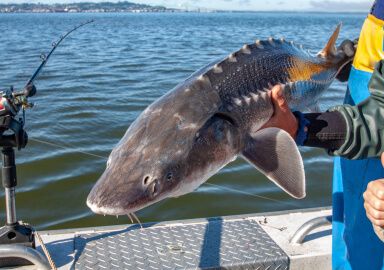Sturgeon
A prehistoric-looking bottom dweller, with its long snout and scute-covered body, the sturgeon is one of the biggest and most valuable freshwater fish in the Northern Hemisphere.
View 9 listings
9
listings
–
price starting from
3
countries
–
to the nearest trip
Where and When?
Some species of sturgeon can be found in most bodies of freshwater in North America, Europe and Asia. The biggest kinds of sturgeon, the beluga and the kaluga, are found in the Caspian Sea and the Amur River basin respectively. However, the endangered or threatened status of most sturgeon species has reduced the sport fishing opportunities.
The best destination for sturgeon fishing is the Pacific Coast of North America. The Fraser River in British Columbia is the prime attraction, but other locations, in Canada as well as Washington and Oregon, also provide excellent opportunities. Some states in the Atlantic and Great Lakes basin have a sturgeon season too. For the travelling angler exotic fishing opportunities for sturgeon exist in some Asian countries such as Tajikistan.
The best time for sturgeon fishing in the American Pacific is believed to be July and August. However, late spring and early autumn may also provide excellent fishing, depending on the temperature of the river in question: the sturgeon are believed to be most active when the water temperatures are between 50-65 degrees Fahrenheit.
About Sturgeon
Sturgeon (Acipenseridae) is one of the oldest existing families of fish, comprising 28 extant species. Bottom feeders, they have a long body with flat belly and powerful, asymmetric tail. Their long snout is covered with a number of barbels, as well as electrosensory organs that help them find their prey in dark and muddy waters of the rivers they prefer. Their skin is covered with scutes rather than scales, which on some species resemble the spine spikes of a dinosaur, contributing to their prehistoric appearance. While some commercially caught sturgeon, the beluga of the Caspian, weighed up 1 ½ tons, the current world angling record for North American sturgeon is 468 pounds for a fish caught in the Fraser River. Click to learn more about life history of the sturgeon
The sturgeon are one of the longest living fish, with lifespan of up to 100 years of age, but they also reach sexual maturity very late in life, at about 15-20 years. This makes the species extremely vulnerable to overfishing, which is very likely to occur because of the sturgeon’s esteemed culinary value. Having practically no bones - the skeleton is made of relatively soft cartilage tissue - the sturgeon is believed to be the most delicious freshwater fish ever, and their eggs (a.k.a. caviar) are prized even higher as a delicacy. This is why all species of the sturgeon are protected, and fishing is either banned or heavily restricted.
How to Catch?
The sturgeon mostly feed on shellfish, crustaceans, and smaller fish that they collect at the bottom, mostly sucking them in from the bentos. This lifestyle reduces the fishing techniques used to catch sturgeon to various kinds of bottom fishing bottom fishing. Live bait, taken to the bottom with the help of a heavy sinker, is probably the most successful way of sturgeon fishing, although vertical jigging and spinning with jigheads can be highly efficient as well.
Although you can catch a sturgeon from the shore, fishing from a boat is a much better option, especially if the boat is equipped with a sonar. For the biggest sturgeon, explore the deepest holes and parts of the river you fish. Heavy tackle is a prerequisite. The sturgeons are strong fighters once hooked, but get tired relatively quickly. Once near the boat, be careful not to grab a sturgeon by the gills; this is dangerous both to the fish, as sturgeon gills are tender and easily damaged, and to your fingers, that would not enjoy the contact with the bony and sharp gill covers.










